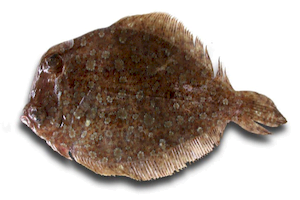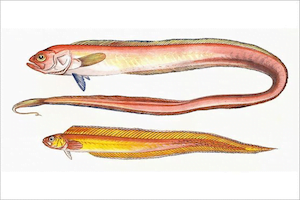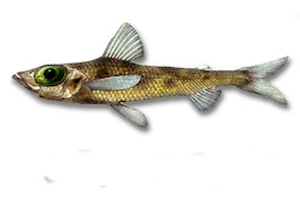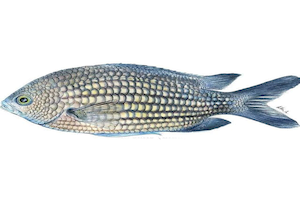Siganus Luridus
– Dusky Spinefoot –


| Conservation status |
|---|
 Least Concern (IUCN 3.1)[1] |
| Scientific classification |
Siganus luridus
(Rüppell, 1829)
| Kingdom: | Animalia |
| Phylum: | Chordata |
| Class: | Actinopterygii |
| Order: | Perciformes |
| Family: | Siganidae |
| Genus: | Siganus |
| Species: | S. luridus |
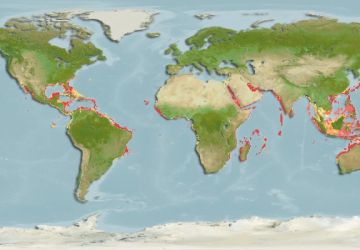
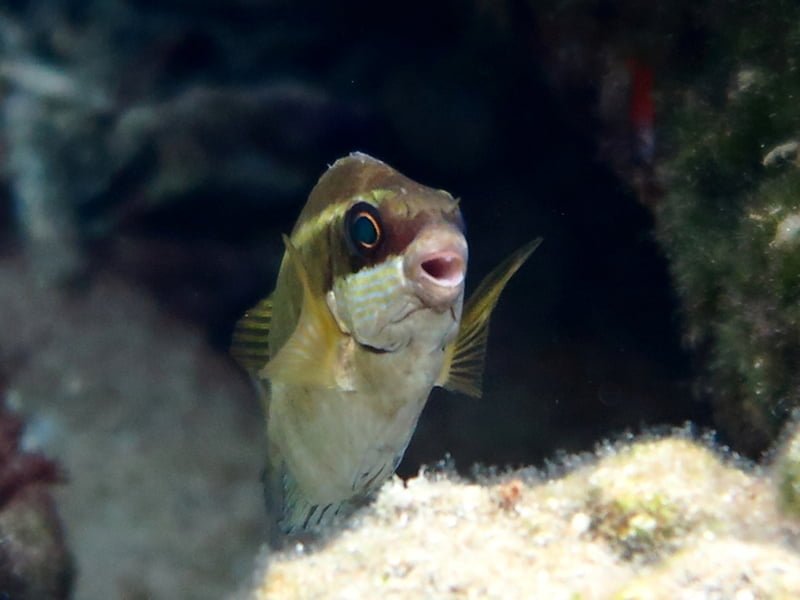
The dusky spinefoot (Siganus luridus) is a species of rabbitfish (Siganidae). It is native to the western Indian Ocean, as well as the Red Sea and Persian Gulf. It has spread to the Mediterranean Sea because of the Suez Canal (Lessepsian migration). It is often found in small schools feeding on benthic algae in shallow water with compacted sand substrates. Its dorsal and anal fin spines contain venom that is not life-threatening to humans.[2][3]
Description
The truncated-tailed rabbitfish has a spindle-shaped body, strongly compressed laterally and very high . Its size is on average 20 cm, but the largest individuals reach 30 cm. Its scales are tiny and its lateral line * is quite arched. The dorsal and anal fins are almost symmetrical and give the rear of the body a somewhat more rectangular appearance . Most often the long backbone is pressed against the body. The anal fin has seven spines, which is not seen in other families of fish. As the name suggests, it has a tail that ends with a straight edge, as if it had been cut with scissors. It can sometimes be weakly convex .
The head is small and the mouth, lined with fleshy labial folds * , is reduced and downward. This mouth has small teeth in the form of incisors (incisors). Between the eyes, a dark horizontal band may be visible. The anterior nostril has a small flattened dermal growth.
The coat of this rabbitfish does not show very marked characteristics and it can be very variable according to its moods and the times of the day, which makes its identification difficult in the presence of close species. This dress may appear uniform, yellow, pale brown or bronze in color , or lighter, silvery, with thin and irregular horizontal stripes,alternating dark and light, the head then presents a darker upper part. At night, as well as under stress, it may show larger mottles or stripes.
Biotope
In its geographic area of origin, this fish is found in shallow water, generally 10 to 20 m deep at most. On the coasts of Israel and Lebanon (according to M. Bariche), it is however caught up to 40 m and it is most abundant around 15 to 20 m.
It swims very close to the bottom, where seagrass and algae abound. For the same reason, it is mostly seen in rocky environments, rather than near predominantly coral areas. It also frequents areas of compacted sand strewn with solid debris: rocks and madreporia.
Similar Species
In the Indian Ocean, the Red Sea and the Mediterranean, Siganus luridus is likely to be confused with Siganus rivulatus , the striped-bellied rabbitfish. The latter has a more elongated silhouette and a dress which most often shows yellow or orange longitudinal streaks on the belly. In general, this coat is lighter than that of Siganus luridus . The tail of Siganus rivulatus has dark vertical streaks, more or less visible, and it ends in a notched manner.
In the Mediterranean, it can possibly be confused with the saupe ( Sarpa salpa ), but the latter has a more silvery dress, with a dozen bright yellow lines, its dorsal and anal fins are less developed and extend its spindle silhouette.
Alimentation
Siganus luridus feeds on a wide variety of benthic algae. Occasionally, it may involuntarily consume the small invertebrates associated with them. Sand can also be ingested, it would intervene in digestion.
Studies carried out in the eastern Mediterranean (Bariche) show that the truncated-tailed rabbitfish have greatly modified their diet to adapt to local conditions, which are very different from those of the Indo-Pacific region. It seems to feed preferentially on the most common algae such as Halopteris spp., Padina spp., Sphacelaria spp., Polysiphonia spp., Ulva spp. and Sargassum spp .. It can also occasionally consume Caulerpa cylindracea which is an introduced species from Australia and poisonous.
Reproduction
In the Red Sea as in the eastern Mediterranean, the reproduction period begins in May, it ends in August in the Red Sea, a month before in the Mediterranean. Fertilization is external. The eggs fall to the bottom, the laying is therefore of the demersal type *, and hatch 26 to 32 hours later.
The larvae live three days below the surface, feeding on phytoplankton * and zooplankton *, before reaching the bottom.
Juveniles can congregate in large schools in sheltered bays.
Associated Life
Wherever they are found, blunt-tailed rabbitfish often join fish of other species to form mixed schools. In Tunisia, we saw them in the company of saupes.
Various Biology
Siganidae have an unusual number of spines on their fins:
– while most other fish have a maximum of 3 on the anal fin, they have 7.
– other fish have a spine only at the front edge of the fin pelvic, they also have a thorn at the posterior edge.
The spines of these fins are poisonous, each related to two poison glands. Their role is essentially defensive.
When it feels facing a potential predator, it spreads its fins and raises its rays, it then becomes a poisonous “pincushion”.
The truncated-tailed rabbitfish evolve in the Indo-Pacific area in small schools of around ten individuals in general. We can sometimes see solitary individuals or in small groups of 3 or 4 individuals.
In the eastern Mediterranean, they were observed (Francour) in very large schools: more than 5,000 individuals in a single school on the Turkish coast in August 2008!
Further Information
Injuries caused to humans by venom thorns are very painful, but the pain is normally transient and of no serious consequence. Professor Quignard, an ichthyologist, pricked himself on the poisonous rays of a half-dead fish and felt pain that persisted for several hours.
The Mediterranean has only a few species of herbivorous animals. This term is normally used to designate animals which consume herbs in the strict sense; we can include Posidonia, large sea grasses, and by extension we also include algae, which have only a very distant relationship with grasses! These herbivores mainly include purple sea urchins ( Paracentrotus lividus ) and saupe ( Sarpa salpa ). As a result, a good number of Mediterranean algae, during their evolution, did not set up chemical defense strategies. These defenses aim to make them toxic, as can be seen in some tropical species, such as caulerpa ( Caulerpaspp.) who had to learn to defend themselves against herbivores in their living environment. A sudden arrival of voracious herbivorous species could therefore, according to some scientists, have dreadful consequences in an environment that contained very few. Others are less alarmist, let’s hope they’re right.
During the twentieth century, through the Suez Canal, two species of Siganidae arrived in the Mediterranean.
In 1927, the striped-bellied rabbitfish ( Siganus rivulatus ) arrived first in the Mediterranean. In 2000, he was seen in the Adriatic Sea. It has not yet reached our shores.
The short-tailed rabbitfish ( Siganus luridus) arrived from 1956 on the Mediterranean coasts of Israel. In 2005, this species was observed in Sicily and, in summer 2008, two individuals were caught near Marseille, in the Côte Bleue Marine Park. These fish, new to our coasts, were reported at that time on the DORIS Forum . One of them lived for almost a year in the aquarium of the premises of the Côte Bleue Marine Park.
These two fish caught near Marseille are very isolated reports. Two hypotheses were retained (Daniel B. et al, 2009) for their arrival in this geographic sector.
First: transport by ballast water from a ship: Marseille is an important port.
Second: transport using marine currents (Ligurian current …) from a known nearby population (Sicily, Tunisia …) or not.
On the coasts of Lebanon, abundance measurements have been carried out (Bariche et al , 2004). 70% of the fish observed are Siganidae. The distribution between these two species has been quantified: Siganus rivulatus : 72%, Siganus luridus : 8%. Therefore the populations of saupes are less than 1%.
The Siganidae are formidable competitors for the saupes because the recruitment * of their larvae is much better, their growth is faster, their sexual maturity is early and their fertility higher!













